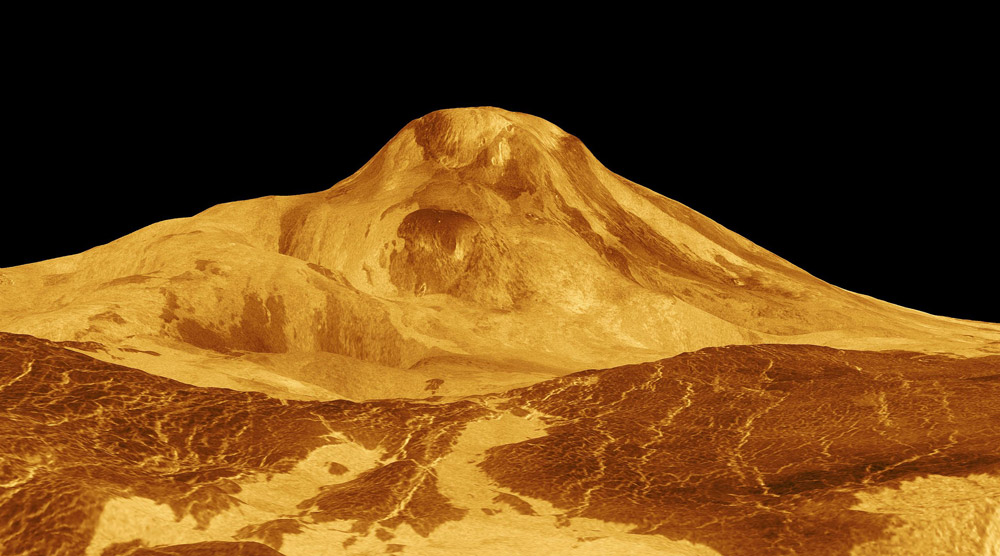Not all volcanoes and pyroclastic flows on Venus are ancient and solidified long ago: Researchers have discovered new evidence of active volcanism on our neighboring planet. A volcanic vent about two kilometers across near the largest volcano on Venus, Ma’at Mons, has changed its shape and size within a few months, new analyzes of radar images from the Magellan probe show. Records indicate that a lava lake formed in the vent and lava flowed.
Venus is similar in size and composition to Earth, and may have been similarly hospitable in its early days. Today, however, conditions are hellish on our neighboring planet, and the thick atmosphere obscures the view of the surface. Only radar images from space probes or ground-based radio telescopes reveal what the landscape of Venus looks like. These images reveal the presence of many volcanoes and lava flows on Venus as well.
But how active are these Venus volcanoes today? In recent decades, space probes have repeatedly provided evidence of possible ongoing volcanic activity. These include notably hot spots on the surface, some of which appear to alter temperature. According to some researchers, some lava flows may only be a few years old.
A new look at old radar data
Robert Herrick and Scott Hensley of the University of Alaska in Fairbanks have now discovered more evidence of active volcanism. They analyzed radar images of the surface of Venus taken by the Magellan spacecraft in the 1990s. “Magellan data has only been made available with full resolution and appropriate processing in the past 10 years,” Herrick explains.
In their study, the researchers focused on possible volcanic regions on the surface of Venus, which Magellan’s probes have repeatedly flown over. This also includes Atla Regio, which contains the two largest volcanoes on Venus, Ozza Mons and Maat Mons. The Daraan volcano rises six and eight kilometers above its surroundings and is surrounded by numerous lava flows and smaller vents.
The chimney changes the content and shape
When comparing images of the northern side of Maat Mons, the team detected gold: In a radar image from February 1991, they detected a 1.5 by 1.8 kilometer volcanic vent on one of the lower shield volcanoes upstream. “This outlet appears almost circular with steeply sloping inner walls,” the researchers stated. The inside also looked empty.
But in the second photo, taken in October of the same year, this chimney looked completely different: no longer round, but elongated. The interior of this vent now appears to be filled with something, as suggested by the short distance between the bottom of the vent and the rim of the pit. “We suspect that a lava lake formed in this vent in the time between the two images,” Herrick and Hensley wrote.
Lava flows under the vent?
And something else could change: On the slope below the volcanic vent, the second radar image showed clear traces of pyroclastic flows that were not visible in the previous image. “The area of these flows is 69 square kilometers – this is consistent with values typical of hot volcanoes on Earth,” the researchers explained. But they also admit that they can’t be sure if the lava flows were really missed in the first shot because it was taken from a slightly different angle.
However, according to scientists, changes in the vent indicate volcanic activity there. Their study thus provides further evidence of ongoing volcanic activity on our neighboring planet. The extent of this activity, however, remains open at present. “Estimates of how often volcanic eruptions may occur on Venus are highly speculative. The likely range is from several large eruptions per year to one volcanic eruption every twelve years,” Herrick explains.
Planned Venus missions can provide certainty
Planetary researchers hope that upcoming Venus missions will provide more information about the volcanoes on Venus. With DaVinci and Veritas, NASA plans to send two space probes to Venus by 2031, including one that will send a daughter probe into the atmosphere. The European Space Agency will send the EnVision Venus probe to our neighboring planet in 2032.
“Next Venus missions will certainly discover new lava flows that have formed since the end of the Magellan mission three decades ago,” says Herrick. Orbital probes may be able to pick up volcanic activity in the act. (54th Congress of Lunar Planetary Science; Science, 2023; doi: 10.1126/science. abm7735)
Source: University of Alaska Fairbanks

“Social media evangelist. Baconaholic. Devoted reader. Twitter scholar. Avid coffee trailblazer.”







More Stories
Is the First Descendant a technical glitch? Tech experts highlight performance issues and more
These brands are most vulnerable to phishing scams
Apple Maps Now Has a Web Version and Wants to Challenge Google Maps